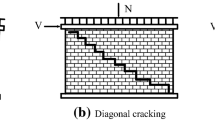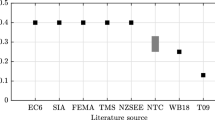Abstract
When testing multi-storey structures, most testing facilities require the testing of a reduced-scale model. A literature review on tests of scaled masonry structural components revealed that scaling of masonry was rather challenging and often significant differences in stiffness, strength and failure mechanisms between the different sized masonry were reported. This paper addresses the scaling of hollow clay brick masonry with fully mortared head and bed joints. We investigate different choices of scaling brick units and mortar joints. Based on the results of an extensive test programme including standard material tests and quasi-static cyclic tests on masonry walls subjected to horizontal and axial loads, we formulate recommendations for the production of a half-scale model of unreinforced masonry structures. The experimental results show a good match between full-scale and half-scale masonry. We discuss the differences in material properties that remained and compare the force-displacement hystereses obtained for the wall tests.















Similar content being viewed by others
References
Abrams DA (1996) Effects of scale and loading rate with tests of concrete and masonry structures. Earthq Spectra 12(1):13–28
Benjamin JR, Williams HA (1958) The behavior of one-story brick shear walls. J Struct Div, Proceedings of the American Society of Civil Engineers, Proc. Paper 1723: 1–30
Brocken HJP, Spielmann ME, Pel L, Kopinga K, Larbi JA (1998) Water extraction out of mortar during brick laying: a NMR study. Mater Struct 31:49–57
CEN (2002) EN 1052–1: Methods of test for masonry—part 1: determination of compressive strength. European Committee for Standardisation, Brussels, Belgium
CEN (2004) Eurocode 8: Design of structures for earthquake resistance—part 3: strengthening and repair of buildings EN 1998–3:2004. European Committee for Standardisation, Brussels, Belgium
CEN (2005) Eurocode 6: Design of masonry structures—part 1–1: general rules for reinforced and unreinforced masonry structures EN 1996-1-1:2005. European Committee for Standardisation, Brussels, Belgium
CEN (2007) EN 1052–3: Methods of test for masonry—part 3: determination of initial shear strength. European Committee for Standardisation, Brussels, Belgium
Davies M, Hughes T, Taunton P (1995) Considerations in the small scale modelling of masonry arch bridges. In: Arch bridges. Thomas Telford, London, pp 365–374
Drysdale RG, Hamid AA (2008) Masonry structures: behavior and design, 3rd edn. The Masonry Society, Boulder
Egermann R, Cook D, Anzani A (1991) An investigation into the behaviour of scale model brick walls. In: Proceedings of the ninth international Brick/Block Masonry conferences. Berlin, Germany, pp 628–635
Frumento S, Magenes G, Morandi P, Calvi GM (2009) Interpretation of experimental shear tests on clay brick masonry walls and evaluation of q-factors for seismic design. IUSS Press, Pavia
Ganz HR (1985) Mauerwerksscheiben unter Normalkraft und Schub. Dissertation, ETH Zürich, Switzerland
Green K, Carter M, Hoff W, Wilson M (1999) The effects of lime and admixtures on the water-retaining properties of cement mortars. Cem Concr Res 29(11):1743–1747
Hamid AA, Abboud B, Harris HG (1986) Direct small scale modeling of grouted concrete block masonry. In: U.S.-PRC joint workshop on seismic resistance of masonry structures. Harbin, China
Hendry AW, Murthy CK (1965) Comparative tests on 1/3- and 1/6-scale models brickwork piers and walls. In: Proceedings of the British Ceramic Society, No. 4, pp 44–66
Hendry AW, Sinha BP (1971) Shear tests on full-scale single-storey brickwork structures subjected to precompression. J. Civil Eng. Public Works Rev. pp 1339–1344
Krawinkler H (1979) Possibilities and limitations of scale-model testing in earthquake engineering. In: Proceedings of the second US national conference on earthquake engineering. Stanford, California, pp 283–292
Lourenço PB, Vasconcelos G, Medeiros P, Gouveia J (2010) Vertically perforated clay brick masonry for loadbearing and non-loadbearing masonry walls. Constr Mater 24(11):2317–2330
Lourenço PB (1997) Two aspects related to the analysis of masonry structures: size effect and parameter sensitivity. Technical report, TU-DELFT No 03.21.1.31.25/ TNO-BOUW No 97-NM-R1533, Faculty of Engineering, TU Delft, Netherlands
Magenes G, Calvi GM (1997) In-plane seismic reponse of brick masonry walls. Earthq Eng Struct Dyn 26:1091–1112
Mohammed A (2006) Experimental comparison of brickwork behaviour at prototype and model scales. Dissertation, Cardiff University, UK
Mohammed A, Hughes T (2011) Prototype and model masonry behaviour under different loading conditions. Mater Struct 44(1):53–65
Petry S, Beyer K (2014) Influence of boundary conditions and size effect on the drift capacity of URM walls. Eng Struct 65:76–88
RILEM (1991) RILEM TC 76-LUM: Diagonal tensile strength tests of small wall specimens. RILEM Publications SARL
Shrive NG, Jessop EL (1980) Anisotropy in extruded clay units and its effect on masonry behaviour. In: Proceedings of the 2nd Canadian masonry symposium, Ottawa, pp 39–50
Sinha BP, Hendry AW (1969) Racking tests on storey-height shear-wall structures with openings subjected to precompression. Designing, engineering and constructing with masonry products, Gulf Publication Co., Houston, Texas, pp 192–199
Tomaževič M (1987) Dynamic modelling of masonry buildings: storey mechanism model as a simple alternative. Earthq Eng Struct Dyn 15(6):731–749
Tomaževič M, Weiss P, Velechovsky T, Modena C (1990) Seismic behaviour of masonry buildings—shaking-table study of masonry buildings with different structural configuration— summary report, models 1,2,3 and 4. Test report, Ministry of Research Activity and Technology, Ljubljana, Slovenia
Tomaževič M, Velechovsky T (1992) Some aspects of testing small-scale masonry building models on simple earthquake simulators. Earthq Eng Struct Dyn 21(11):945–963
Acknowledgments
The authors thank the two reviewers for their comments that helped improving the manuscript. The authors would also like to thank Morandi Frères SA and in particular Philip Piguet, Switzerland, for the effort put into the production of the small-scale bricks and for the donation of the small- and full-scale bricks. Thanks also to Salvatore Marino for his help during testing of the reduced-scale walls.
Author information
Authors and Affiliations
Corresponding author
Rights and permissions
About this article
Cite this article
Petry, S., Beyer, K. Scaling unreinforced masonry for reduced-scale seismic testing. Bull Earthquake Eng 12, 2557–2581 (2014). https://doi.org/10.1007/s10518-014-9605-1
Received:
Accepted:
Published:
Issue Date:
DOI: https://doi.org/10.1007/s10518-014-9605-1




